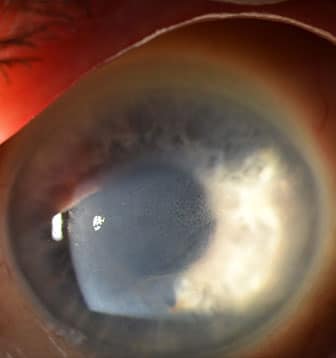What is Fuchs’ Dystrophy?
Fuchs’ corneal dystrophy is a genetic disorder in which the innermost layers of cells of the cornea die and stop functioning adequately. The function of these cells is to pump fluid out of the cornea to keep it clear and thin. When they stop working well or there are not enough of them, the cornea swells and the vision becomes cloudy. This process tends to be very slow, occurring over many years or even decades. The earliest signs of Fuchs’ dystrophy often start to show around age 40. Fuchs’ dystrophy in its earliest stages can be treated with special salt ointments at night and salt drops in the morning. As it progresses, a corneal transplant may be required to substantially improve vision. Most corneal transplants for Fuchs’ dystrophy are now of the endothelial keratoplasty type (DSEK, DSAEK, DMEK) although penetrating keratoplasty (PKP) is also used.

Corneal Swelling

Fuchs’ Dystrophy endothelium (left), Normal endothelium (right)
IF I HAVE FUCHS’ DYSTROPHY, WHAT ARE THE CHANCES THAT MY CHILDREN OR OTHER FAMILY MEMBERS ALSO HAVE OR WILL DEVELOP FUCHS’ DYSTROPHY?
Genetic testing is now available to help determine if you or your family members have genes connected with Fuchs’ Dystrophy. This testing is now available in Dr. Vital’s office. Research is ongoing.


